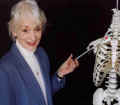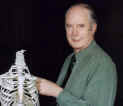 |
 |
 |
Helping You To Achieve ©™

![]()
Helping You To Achieve ©™
|
|
Identify by palpation and surface mark with a pen, the Greater Tubercle of the Humerus on a model in the anatomical position, with side lighting and a time limit of one minute
Objective No 5- Criteria to be demonstrated. 1. Identify the Acromion Process (Objective No 4) 2. Palpate the posterior Acromial angle. 3. Move the palpating finger forward along prominent lateral edge of the Acromion process which is covered by the middle fibres of the Deltoid muscle. 4. The Greater Tubercle forms the most lateral bony feature of the Shoulder being placed approximately 2cms below the lateral edge of the Acromion process beneath the Middle fibres of Deltoid and lies in an anterior position and inferior to the Posterior angle of the Acromion process.5. With the palpating finger tip on the Greater tubercle, the model is requested to rotate the humerus . 6. The Greater tubercle of the humerus rotates under the palpating finger tip of the examiner.
|
Service ProvisionBronze. Students may take up a ,'Free start up ' package consisting of 100 of the behavioural objectives and criteria based on common questions asked in Living Anatomy. These are available free of charge on this Website. Silver. Students may buy a copy of the book "Surface and Living Anatomy" (ISBN: 0 7234 3261 9) which comes with a CD Rom (Windows PC format) containing 230 objectives which includes the 100 behavioural objectives contained in the Bronze Service. Gold "Helping you to Achieve" Contact Information
|